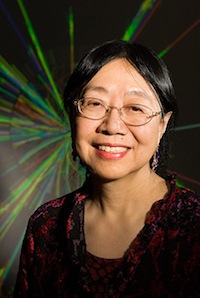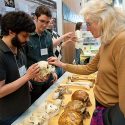Prominent UW physicist describes Higgs search and discovery
On July 4, 2012, the international science community exploded with excitement as physicists at the European Organization for Nuclear Research (CERN) announced the discovery of a brand-new subatomic particle widely believed to be the long-sought Higgs boson.

Sau Lan Wu is pictured in front of a computer-generated simulation of the paths of subatomic particles produced in the ATLAS experiment.
Photo: Jeff Miller
The Higgs boson was first postulated in 1964 as an explanation for why matter has mass. Finding experimental evidence of its existence has been one of the primary goals of scientists working at the Large Hadron Collider (LHC). For Sau Lan Wu, University of Wisconsin–Madison Enrico Fermi and Vilas Professor of Physics, it has been a quest of more than 20 years across three different experiments.
Wu heads a large UW–Madison research team based at the LHC near Geneva, Switzerland, that works on ATLAS, one of the two largest experiments at CERN. On Sept. 20, the campus and Madison community will have the opportunity to hear her account of the Higgs search and discovery process.
Wu will present a public lecture titled “Discovery of the Higgs — the God Particle” from 4-5 p.m. in the H. F. DeLuca Forum at the Wisconsin Institutes for Discovery, 330 N. Orchard St. Part of the Wisconsin Alumni Research Foundaation’s Essential Topics Series, the talk is sponsored by WARF, the offices of the UW–Madison chancellor and provost, the Graduate School and the College of Letters & Science.
UW-Madison has dozens of scientists, including numerous graduate students and postdoctoral fellows, involved in the experiments, analysis, data handling and computation at the LHC. Wisconsin groups play key physics roles in both the ATLAS and CMS experiments, and the UW–Madison-led Open Science Grid provides both experiments with considerable computing resources.
Wu has been searching for the Higgs boson for more than two decades as a key member of the ATLAS experiment and others. Her large research group at CERN has concentrated on particle discovery, studying simulated particle collisions and scrutinizing data coming from ATLAS to look for evidence of the Higgs boson and focusing particularly on the two channels of particle production that led to the discovery.
“I have been looking for you for over 20 years,” Wu told Higgs. He replied, “Now you have found me.”
“We have been working for a large number of years looking for the Higgs,” she says. “This has been a very major effort from our group.”
Wu has a strong history of discovery, having been involved in the identification in the 1970s of the J/psi particle and the gluon, two particles that have contributed to the Standard Model of particle physics. For the gluon discovery, she shared the 1995 High Energy and Particle Physics Prize of the European Physical Society.
Wu has a Ph.D. in particle physics from Harvard University and is a fellow of the American Academy of Arts and Sciences.
Wu has been a UW–Madison professor since 1977. Nearly 50 graduate students have obtained doctorates under her supervision during that time, including those whose analysis contributed to this summer’s discovery.
Her Sept. 20 talk, free and open to the public, will provide an inside look at the Higgs search and the excitement of discovery. It will be followed by a reception in the north atrium of the Wisconsin Institutes for Discovery. Pre-registration is requested.
Later this fall, Wu will present another public lecture about the Higgs particle sponsored by the Department of Physics. That talk will take place on Oct. 19 at 3:30 p.m. in 2241 Chamberlin Hall.
At the July CERN seminar announcing the new particle, Wu had the opportunity to meet Peter Higgs, the theoretical physicist whose name has been attached to the anticipated particle. “I have been looking for you for over 20 years,” she told him.
Higgs replied, “Now you have found me.”


